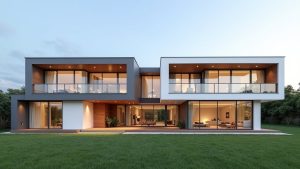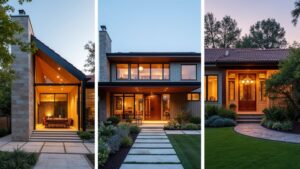India offers stunning house design ideas that fuse traditional architecture with modern elements, exemplified by hybrid styles like Vesara. Interior spaces embrace maximalism, featuring bold furnishings and rich textiles. Innovative kitchens prioritize functionality with creative layouts and vibrant color schemes. Spiritual sanctuaries, or pooja rooms, radiate calm through minimalist designs and natural materials. Sustainable exteriors incorporate green roofs and vertical gardens, enhancing aesthetics and eco-friendliness. Discover more diverse concepts and inspirations for creating extraordinary homes.
Key Takeaways
- Embrace architectural fusion by blending traditional styles with modern design, creating unique, culturally rich spaces in your home.
- Implement maximalism in interior design with bold colors, vibrant textiles, and oversized furniture for an expressive living atmosphere.
- Focus on innovative kitchen designs that prioritize functionality with varied layouts, natural light, and striking color schemes.
- Create serene pooja rooms featuring minimalist aesthetics and traditional materials like wood and marble for a spiritually enriching environment.
- Integrate sustainable exterior concepts by using eco-friendly materials, vertical gardens, and green roofs for enhanced aesthetics and environmental benefits.
Architectural Fusion: Harmonizing Tradition With Modernity
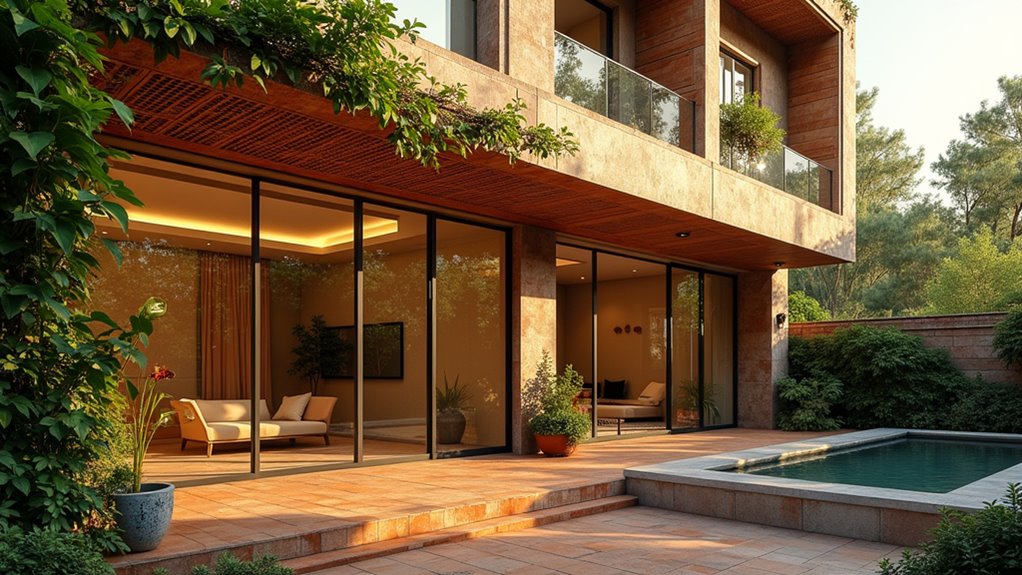
Architectural fusion in India epitomizes the harmonious integration of traditional principles with modern design aesthetics, resulting in spaces that reflect cultural heritage while meeting contemporary needs. This approach incorporates traditional motifs from Vastu Shastra and indigenous spatial organizations within contemporary layouts, ensuring functionality alongside spiritual harmony. Notable examples include Laurie Baker’s St. John’s Cathedral, blending temple elements with modern forms, and residences utilizing climate-responsive features like courtyards and jali screens. Furthermore, the impact of colonial history significantly influences how architects hybridize vernacular elements with modernism in their designs. Additionally, the timeless architectural silhouette of traditional houses, like the Bahay Kubo, serves as an inspirational model for creating sustainable and resilient homes in India. The Vesara hybrid architectural style enriches innovations by merging Nagara and Dravidian influences, achieving a balance between ornamentation and structural integrity. This fusion is also evident in the works of Le Corbusier and Chandigarh, which showcase how modern architecture transforms urban landscapes while respecting cultural contexts.
Embracing Maximalism: A Vibrant Approach to Interior Design
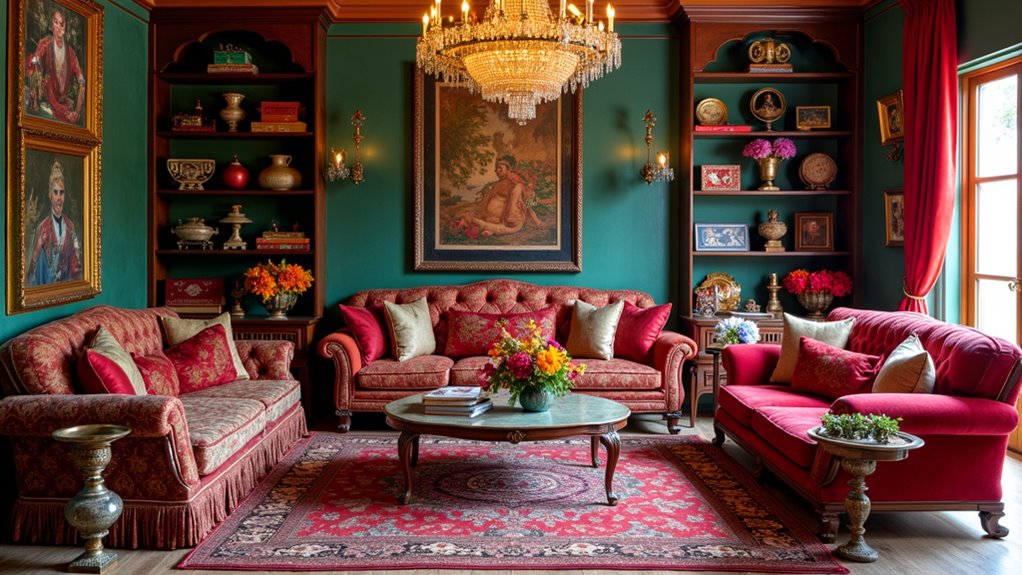
In contemporary interior design, maximalism emerges as a bold counterpoint to minimalism, celebrating abundance and vibrant expression within living spaces. This approach incorporates grand decor featuring personalized large wallpapers and bold furnishings, creating striking visual impact.
Maximalist textiles, rich in color and pattern, further enhance interiors, drawing on luxurious materials such as velvet and silk for curtains and pillows. The use of bold color palettes inspired by Indian culture adds depth and warmth to homes.
Oversized furniture pieces and imaginative lighting choices, including pendant lights and extravagant chandeliers, provide artistic focal points. This harmonious fusion of layers and textures redefines luxurious appeal, making maximalism a distinctive choice for those seeking a vibrant and expressive ambiance in their homes.
Innovative Kitchen Designs: The Heart of the Home

As the focal point of modern homes, innovative kitchen designs blend functionality with aesthetic appeal, catering to the dynamic Indian lifestyle. Transforming these spaces involves embracing varied kitchen layouts and bold color schemes that reflect contemporary trends.
Key elements include:
- U-shaped and Galley Layouts: Optimize space while enhancing workflow and storage.
- Bold Color Schemes: Rich hues like blues and greens contrast elegantly with sleek black cabinetry, shifting away from traditional neutrals.
- Natural Light Integration: Expansive windows and glass doors not only brighten kitchens but also blur the lines between indoors and outdoors.
These innovations elevate kitchen functionality and style, creating inviting environments that encourage social interaction and culinary creativity.
Creating Spiritual Spaces: Pooja Room Inspirations
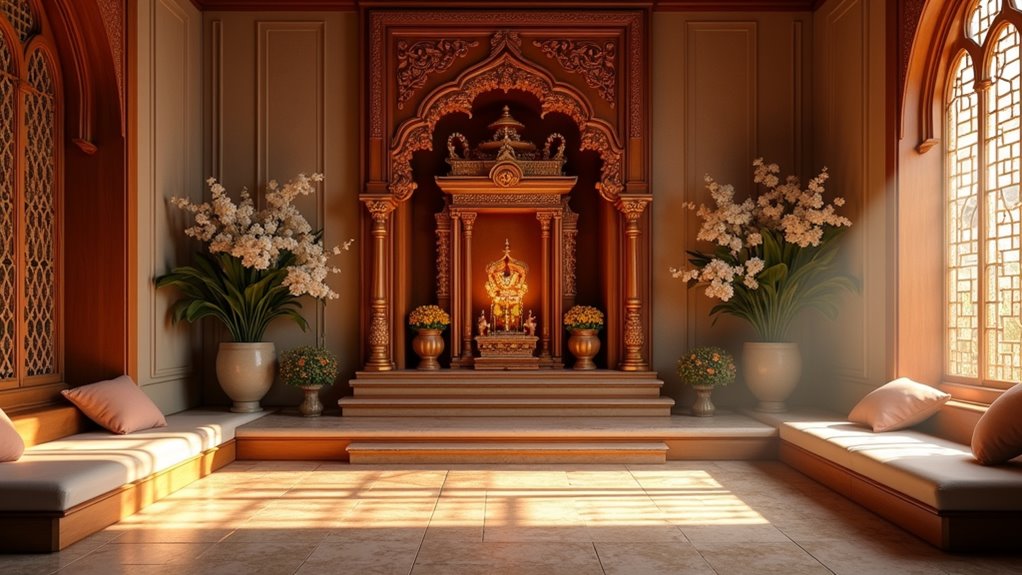
While creating a pooja room, careful consideration of design elements is essential to establish a serene and spiritual atmosphere.
Modern trends favor minimalist aesthetics, utilizing simple lines and uncluttered spaces while also allowing for ornate features that evoke tradition. Incorporating traditional materials such as wood and marble builds warmth, while illuminated interiors enhance the visual appeal. Cultural symbols, like ‘Om’ embossed on walls, enrich the environment with spiritual significance.
The use of low wooden stools for seating ensures comfort during meditation, and colorful cushion coverings introduce vibrancy. Decorative accents, such as mirror designs and delicate string lights, provide flexibility in decor without overwhelming the space, promoting a tranquil and inviting sanctuary for daily prayers and reflection. To enhance the atmosphere of connection with nature, consider integrating gardens and water features that promote harmony and tranquility.
Sustainable Exterior Concepts: Blending Nature With Design
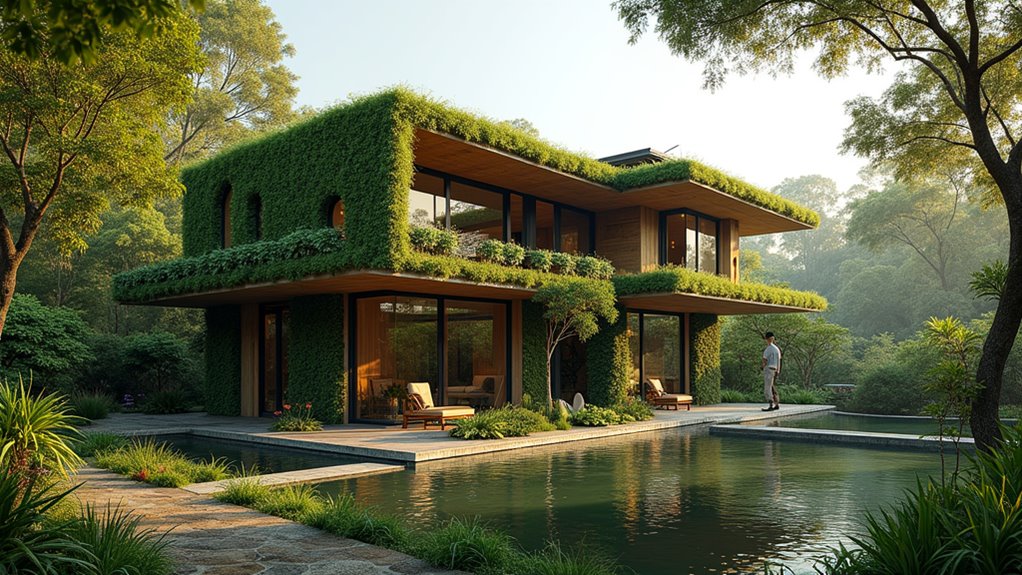
How can architectural design harmoniously integrate with the natural environment without sacrificing aesthetics or functionality? Sustainable exterior concepts provide innovative solutions that emphasize eco-friendly materials and green integration.
By incorporating nature into design, homes can achieve visual appeal while enhancing environmental responsibility. Key strategies include:
- Vertical Gardens: These not only improve air quality but also serve as stunning focal points in exterior design.
- Green Roofs: Offering thermal insulation and a habitat for local biodiversity, green roofs are a sustainable choice that enhances living spaces.
- Recycled Materials: Utilizing recycled materials in construction minimizes waste and reflects modern aesthetics, contributing to reduced carbon footprints.
Additionally, designs incorporating natural materials can enhance both aesthetic appeal and structural durability, ensuring a long-lasting integration with the environment.
Ultimately, these concepts enable a seamless blend of nature and built environments, promoting a sustainable future.




